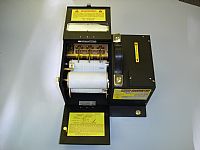Displacement
These recorders will register displacement if the natural frequency of the instrument is sufficiently less than that of the impressed frequency.Frequency
The frequency of any recorder having a weight restrained by a spring is dependent upon one fact-the amount the weight must move per G.The frequency formula is an inverse square function. For example, a recorder having a natural frequency of 20 hertz has a displacement of .0245 inches per G. If the recorder frequency is increased to 40 hertz, then either the weight or spring must be changed so movement under a 1 G load is reduced to 1/4 of .0245 inches, or .0061 inches. It's this inherent factor that makes it necessary to produce instruments with precision and extremely close tolerances. It can be readily seen that it would be impractical to read a chart where 1 G would be equal to .0061 inches. To make a satisfactory, moderately high frequency instrument, there must be multiplication between the movement of the weight and the recording stylus to produce a record that can be read with reasonable accuracy. Our recorders have been produced with multiplication ratios of as high as approximately 30 to 1

